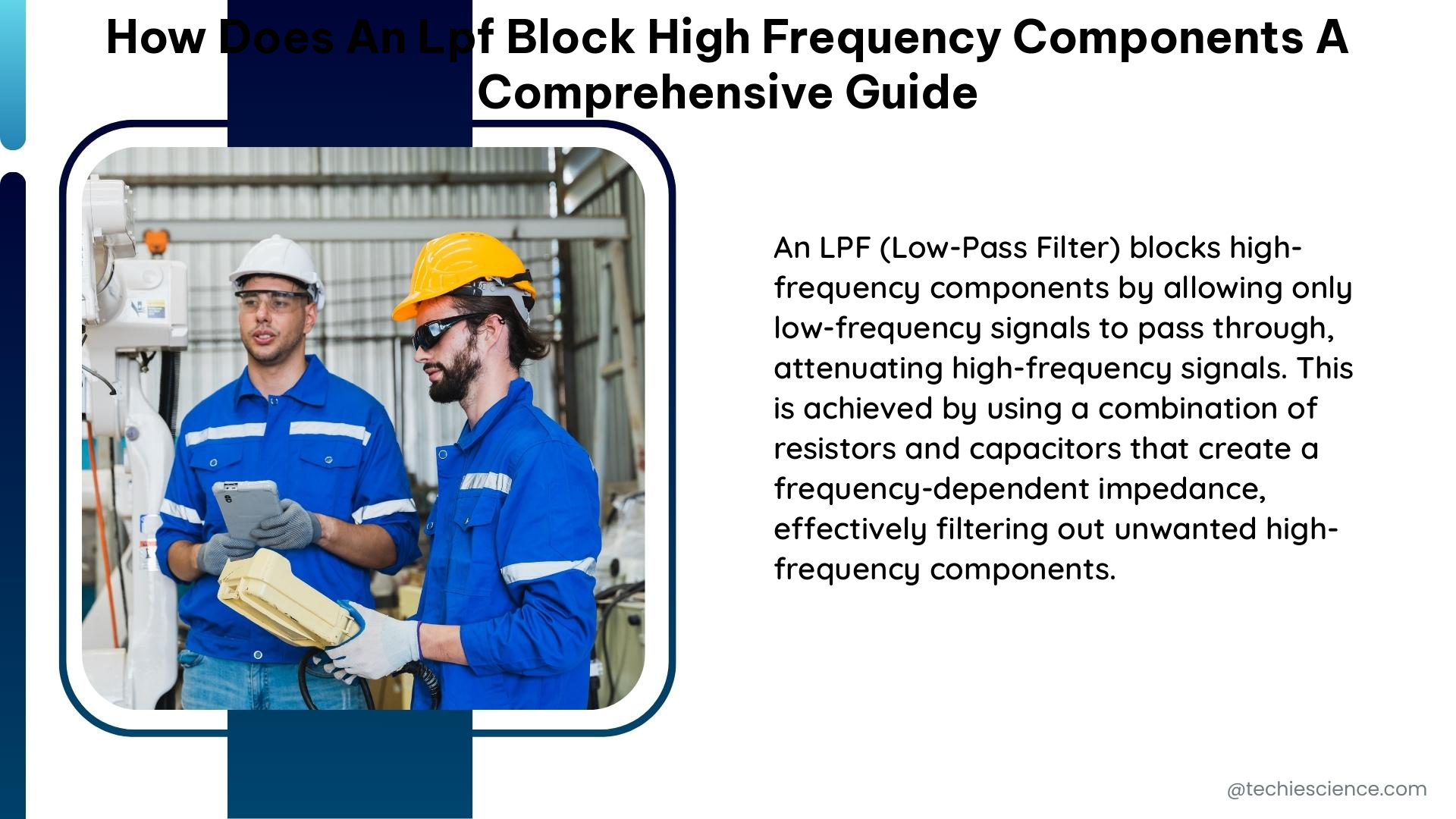A low-pass filter (LPF) is a fundamental electronic filter that selectively passes signals with frequencies lower than a specified cutoff frequency while attenuating signals with frequencies higher than the cutoff. This comprehensive guide delves into the inner workings of LPFs, exploring how they effectively block high-frequency components and provide a wealth of technical details to help electronics students and enthusiasts gain a deep understanding of this crucial filtering technique.
Understanding the Cutoff Frequency and Passband Gain
The cutoff frequency (fc) of an active LPF using an operational amplifier is defined by the equation:
$f_{c} = \frac{1}{2\pi R_{2}C}$
where R2 is the feedback resistor and C is the capacitor value. Alternatively, the cutoff frequency can be expressed in radians per second (ωc) as:
$\omega_{c} = \frac{1}{R_{2}C}$
The gain in the passband of an LPF is determined by the ratio of the feedback resistor (R2) to the input resistor (R1), and is given by the equation:
$A_{v} = -\frac{R_{2}}{R_{1}}$
For example, if R2 = 10 kΩ and R1 = 1 kΩ, the passband gain would be -10, or -20 dB.
Frequency Response and Stopband Attenuation

The frequency response of an LPF is characterized by a gradual roll-off in the stopband, with a slope of -6 dB per octave (or -20 dB per decade). This means that for every doubling of the frequency above the cutoff, the signal amplitude is attenuated by a factor of 2 (or 6 dB).
For a first-order LPF, the frequency response can be expressed as:
$H(f) = \frac{1}{\sqrt{1 + (\frac{f}{f_{c}})^{2}}}$
where f is the input frequency and fc is the cutoff frequency.
Designing a Third-Order FIR LPF
In the context of removing high-frequency noise from measured data, a third-order finite impulse response (FIR) low-pass filter can be designed using the DSP System Toolbox™ in MATLAB®. This filter effectively keeps low-frequency components while attenuating high-frequency components with a period of less than 24 hours.
The key steps in designing the third-order FIR LPF are:
- Determine the sampling frequency (Fs) based on the data collection rate. For example, if the data is collected once per minute, Fs = 1/60 Hz.
- Specify the desired cutoff frequency (Fc) to target the high-frequency noise. For example, Fc = 1/(24 hours) = 1.157 × 10^-5 Hz.
- Use the
fir1()function to design the third-order FIR filter with the specified Fs and Fc. - Apply the filter to the measured data using the
filtfilt()function to remove the high-frequency noise.
The effectiveness of this filtering process can be observed in a plot that demonstrates a dramatic reduction in high-frequency noise.
Practical Example: Filtering Relative Humidity Data
To further illustrate the application of an LPF, consider the following example:
The ThingSpeak™ channel 12397 contains data from the MathWorks® weather station located in Natick, Massachusetts. The data is collected and posted to ThingSpeak once per minute. Field 3 of the channel contains relative humidity data, which can be read using the thingSpeakRead function.
To remove the high-frequency noise in the relative humidity data, a low-pass filter is designed with a sampling frequency of once every 60 seconds (Fs=1/60 Hz) and a cutoff frequency of 1/(24 hours) = 1.157 × 10^-5 Hz. This filter keeps the low-frequency components and attenuates the high-frequency components with a period of less than 24 hours.
The processed relative humidity data is then sent to a ThingSpeak channel using the thingSpeakWrite function, providing a clean and filtered signal for further analysis or visualization.
Advanced Considerations
While the basic principles of LPFs have been covered, there are several advanced topics and considerations that can be explored further:
- Higher-Order LPFs: Higher-order LPFs, such as second-order or fourth-order, can provide steeper roll-off in the stopband and improved attenuation of high-frequency components.
- Butterworth, Chebyshev, and Elliptic Filters: These filter types offer different trade-offs between passband flatness, stopband attenuation, and transition band sharpness, allowing for more customized filter design.
- Analog vs. Digital LPFs: The implementation of LPFs can be done in both the analog and digital domains, each with its own advantages and considerations.
- Practical Considerations: Real-world factors, such as component tolerances, temperature effects, and noise, can impact the performance of LPFs and should be taken into account during the design process.
By delving into these advanced topics, electronics students and enthusiasts can further expand their understanding of low-pass filters and their applications in various electronic systems and signal processing scenarios.
Conclusion
In this comprehensive guide, we have explored the fundamental principles of low-pass filters and how they effectively block high-frequency components. We have covered the mathematical equations governing the cutoff frequency, passband gain, and frequency response, as well as the design of a third-order FIR LPF using the DSP System Toolbox™. The practical example of filtering relative humidity data has provided a tangible application of LPFs in real-world scenarios.
By understanding the technical details and inner workings of low-pass filters, electronics students and enthusiasts can gain a deeper appreciation for this essential filtering technique and its widespread applications in various electronic systems and signal processing domains.
References
- Remove High-Frequency Noise in Measured Data – MathWorks. (n.d.). Retrieved from https://www.mathworks.com/help/thingspeak/remove-high-frequency-noise-in-measured-data.html
- Low Pass, High Pass and Band Pass Filters – Simple Explanation. (2022, July 30). Retrieved from https://www.rfpage.com/low-pass-high-pass-and-band-pass-filters-simple-explanation/
- Low-pass filter – Wikipedia. (n.d.). Retrieved from https://en.wikipedia.org/wiki/Low-pass_filter
- Electronic Filter | Low Pass, High Pass, Band Pass, and Band Stop. (2023, November 22). Retrieved from https://www.electronicsforu.com/technology-trends/learn-electronics/band-stop-high-low-pass-filter

The lambdageeks.com Core SME Team is a group of experienced subject matter experts from diverse scientific and technical fields including Physics, Chemistry, Technology,Electronics & Electrical Engineering, Automotive, Mechanical Engineering. Our team collaborates to create high-quality, well-researched articles on a wide range of science and technology topics for the lambdageeks.com website.
All Our Senior SME are having more than 7 Years of experience in the respective fields . They are either Working Industry Professionals or assocaited With different Universities. Refer Our Authors Page to get to know About our Core SMEs.